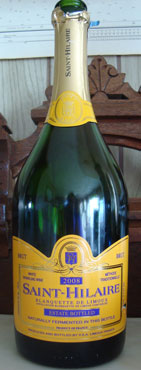Blanquette de Limoux
Blanquette de Limoux, Blanquette méthode ancestrale, Crémant de Limoux
The sparkling wines of Limoux have been produced for about a century longer than Champagne and there are three designations (or AOCs): Blanquette de Limoux, Blanquette méthode ancestrale, and Crémant de Limoux, as well as a still wine, simply known as Limoux. They are produced around the city of Limoux in Languedoc, southwest France, in the foothills of the Pyrénées.
Supposedly the first sparkling wine ever was made in Limoux in in 1531, by the monks at the abbey in Saint-Hilaire, sometimes misspelled Saint-Hillaire. There are three grapes traditionally used for white wines, Mauzac, Chardonnay and Chenin Blanc.
Mauzac is primarily grown in southwestern France and locally called Blanquette, although it is also one of the 7 allowed grapes for white Bordeaux as well. Mauzac is falling out of favor in Limoux and plantings are being replaced by Chardonnay, although it is required in Blanquette de Limoux. Since 2005 a red wine based on a minimum of 50% Merlot with Cardigan, Grenache, Malbec, Syrah, Cabernet Sauvignon, and Cabernet Franc also allowable also been produced.
 Blanquette de Limoux
Blanquette de Limoux
The term "Blanquette de Limoux" has been used for a long time. Today, it must contain 90% minimum Mauzac with Chardonnay and Chenin Blanc also allowed (prior to 1990 Mauzac was optional, but very traditional). The grapes are vinified separately before blending and bottling. Before the first bottling, a small amount of sugar called a tirage is added so that a second fermentation takes place in the bottle making the wine sparkling. Nine months later the bottles are opened and disgorged before a final bottling. President Thomas Jefferson was a fan of this wine!
Blanquette méthode ancestrale
Blanquette méthode ancestrale wines are made just as they were by the monks in 1531, entirely of Mauzac and without disgorgement. This means they are cloudy from the Lees, or dead yeast cells. These wines are naturally low in alcohol, 7% or less.
Crémant de Limoux
The term Crémant first started being used in 1990 in France in many regions to refer to more internationally styled sparkling wines. Crémant de Limoux differs from Blanquette de Limoux primarily in the grape percentages and grapes used. Blanquette de Limoux must be at least 90% Mauzac, and the rest Chardonnay and Chenin Blanc. Crémant de Limoux is only 10 to 20% Mauzac with 40 to 70% Chardonnay, 20 to 40% Chenin Blanc, and even up to 10% Pinot Noir allowed!
I located a bottle of perhaps the best known wine of the Blanquette de Limoux, Blanquette méthode ancestrale, and Crémant de Limoux trio, Saint-Hilaire Blanquette de Limoux while in France. Unfortunately I didn't drink it but found the same bottle in the New Hampshire Liquor Stores and a favorable tasting note follows!
Saint-Hilaire 2008 Blanquette de Limoux Brut
Saint-Hilaire exists in Brut, Extra Dry, and Semi Sweet varieties, and this is a tasting note for the Brut, the driest of the three.
The color is very light, white/clear with a tinge of straw.
The nose is pear, bread dough, and especially apple peel.
This is a light bodied and very pleasant wine, with white fruits like pear and apple and once again apple peel thanks to the Mauzac.
Not a wine to age but one to enjoy fresh. Quite pleasant and absolutely lovely. Under $20 too, and widely available!
